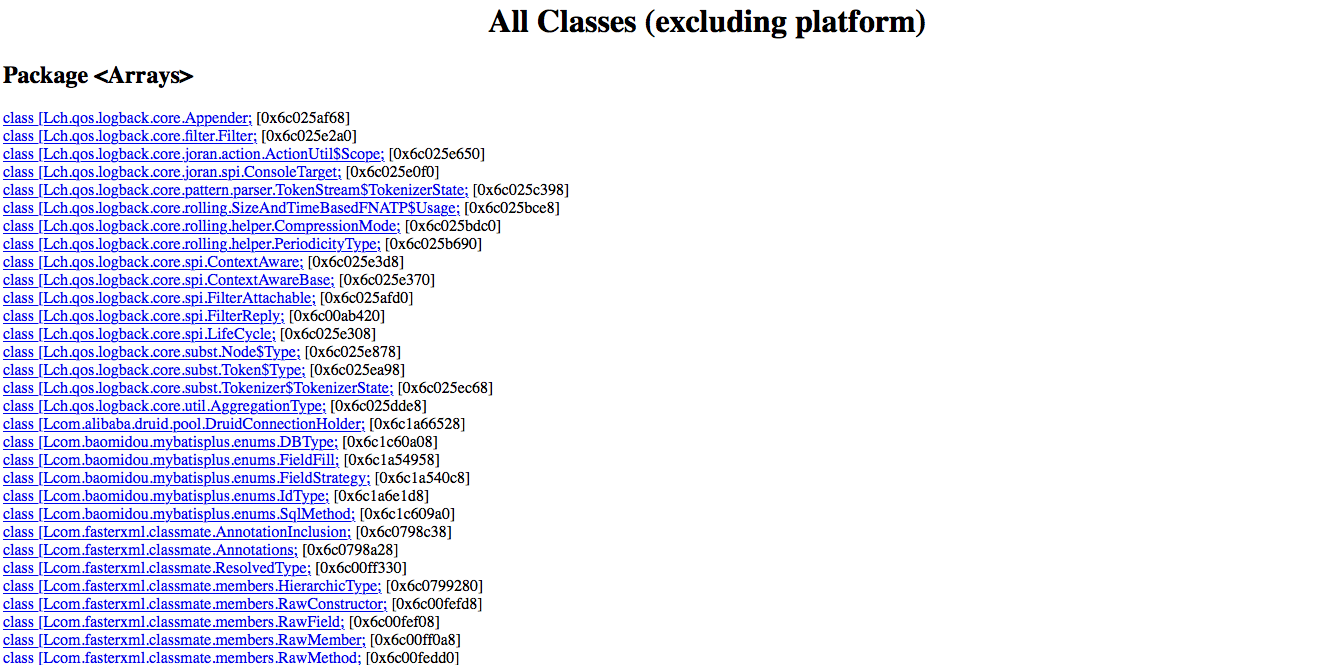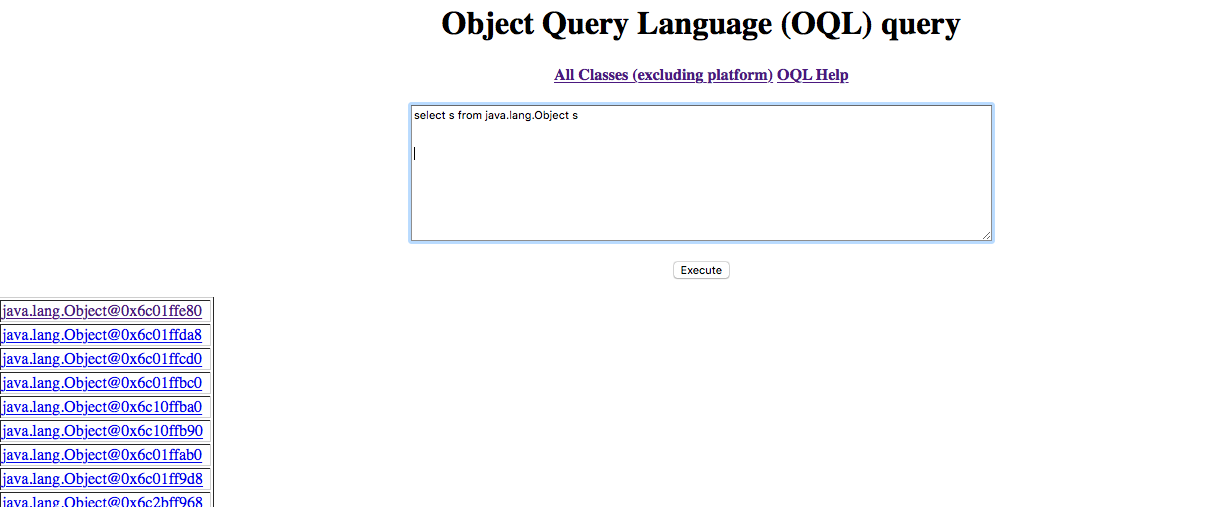OQL是对java堆内存进行查询分析
使用方法:
1.查看java线程id
jps -lvm

上图红框中的为pid;
2.运行命令-导出堆内存信息-会生成一份文件在你本地
jmap -dump:live,file=a.map 10736

3.解析该文件-会展示为html
jhat a.map

4.在浏览器打开地址
http://127.0.0.1:7000/oql/ 命令查询页面
主页面如下:

查询页面如下:

总结:使用命令如下:
jps -lvm 查询pid
jmap -dump:live,file=a.map 10736 导出堆内存
jhat a.map 解析内存文件
http://127.0.0.1:7000/oql/ 浏览器打开
附录:
基本语法:
select <javascript expression to select>
[from [instanceof] <class name> <identifier>]
[where <javascript boolean expression to filter>]
解释:
(1)class name是java类的完全限定名,如:java.lang.String, java.util.ArrayList, [C是char数组, [Ljava.io.File是java.io.File[]
(2)类的完全限定名不足以唯一的辨识一个类,因为不同的ClassLoader载入的相同的类,它们在jvm中是不同类型的
(3)instanceof表示也查询某一个类的子类,如果不明确instanceof,则只精确查询class name指定的类
(4)from和where子句都是可选的
(5)java域表示:obj.field_name;java数组表示:array[index]
举例:
(1)查询长度大于100的字符串
select s from java.lang.String s where s.count > 100
(2)查询长度大于256的数组
select a from [I a where a.length > 256
(3)显示匹配某一正则表达式的字符串
select a.value.toString() from java.lang.String s where /java/(s.value.toString())
(4)显示所有文件对象的文件路径
select file.path.value.toString() from java.io.File file
(5)显示所有ClassLoader的类名
select classof(cl).name from instanceof java.lang.ClassLoader cl
(6)通过引用查询对象
select o from instanceof 0xd404d404 o
built-in对象 -- heap
(1)heap.findClass(class name) -- 找到类
select heap.findClass("java.lang.String").superclass
(2)heap.findObject(object id) -- 找到对象
select heap.findObject("0xd404d404")
(3)heap.classes -- 所有类的枚举
select heap.classes
(4)heap.objects -- 所有对象的枚举
select heap.objects("java.lang.String")
(5)heap.finalizables -- 等待垃圾收集的java对象的枚举
(6)heap.livepaths -- 某一对象存活路径
select heaplivepaths(s) from java.lang.String s
(7)heap.roots -- 堆根集的枚举
辨识对象的函数
(1)classof(class name) -- 返回java对象的类对象
select classof(cl).name from instanceof java.lang.ClassLoader cl
(2)identical(object1,object2) -- 返回是否两个对象是同一个实例
select identical(heap.findClass("java.lang.String").name, heap.findClass("java.lang.String").name)
(3)objectid(object) -- 返回对象的id
select objectid(s) from java.lang.String s
(4)reachables -- 返回可从对象可到达的对象
select reachables(p) from java.util.Properties p -- 查询从Properties对象可到达的对象
select reachables(u, "java.net.URL.handler") from java.net.URL u -- 查询从URL对象可到达的对象,但不包括从URL.handler可到达的对象
(5)referrers(object) -- 返回引用某一对象的对象
select referrers(s) from java.lang.String s where s.count > 100
(6)referees(object) -- 返回某一对象引用的对象
select referees(s) from java.lang.String s where s.count > 100
(7)refers(object1,object2) -- 返回是否第一个对象引用第二个对象
select refers(heap.findObject("0xd4d4d4d4"),heap.findObject("0xe4e4e4e4"))
(8)root(object) -- 返回是否对象是根集的成员
select root(heap.findObject("0xd4d4d4d4"))
(9)sizeof(object) -- 返回对象的大小
select sizeof(o) from [I o
(10)toHtml(object) -- 返回对象的html格式
select "<b>" + toHtml(o) + "</b>" from java.lang.Object o
(11)选择多值
select {name:t.name?t.name.toString():"null",thread:t} from instanceof java.lang.Thread t
数组、迭代器等函数
(1)concat(enumeration1,enumeration2) -- 将数组或枚举进行连接
select concat(referrers(p),referrers(p)) from java.util.Properties p
(2)contains(array, expression) -- 数组中元素是否满足某表达式
select p from java.util.Properties where contains(referres(p), "classof(it).name == 'java.lang.Class'")
返回由java.lang.Class引用的java.util.Properties对象
built-in变量
it -- 当前的迭代元素
index -- 当前迭代元素的索引
array -- 被迭代的数组
(3)count(array, expression) -- 满足某一条件的元素的数量
select count(heap.classes(), "/java.io./(it.name)")
(4)filter(array, expression) -- 过滤出满足某一条件的元素
select filter(heap.classes(), "/java.io./(it.name)")
(5)length(array) -- 返回数组长度
select length(heap.classes())
(6)map(array,expression) -- 根据表达式对数组中的元素进行转换映射
select map(heap.classes(),"index + '-->' + toHtml(it)")
(7)max(array,expression) -- 最大值, min(array,expression)
select max(heap.objects("java.lang.String"),"lhs.count>rhs.count")
built-in变量
lhs -- 左边元素
rhs -- 右边元素
(8)sort(array,expression) -- 排序
select sort(heap.objects('[C'),'sizeof(lhs)-sizeof(rhs)')
(9)sum(array,expression) -- 求和
select sum(heap.objects('[C'),'sizeof(it)')
(10)toArray(array) -- 返回数组
(11)unique(array) -- 唯一化数组